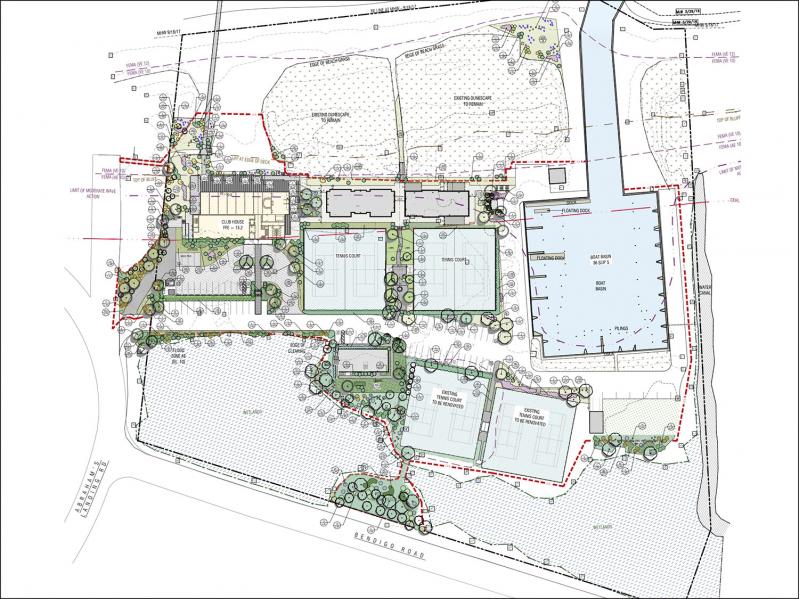“That was a journey down a rabbit hole,” Ed Johann, a member of the East Hampton Town Zoning Board of Appeals, said after an exhaustive discussion regarding the redevelopment of the Devon Yacht Club split the board last week.
Roy Dalene, the chairman, and Mr. Johann seemed ready to send the application back to the planning board, indicating their probable approval for the “involved” and “complicated” project, which, in short, involves the demolition of six buildings and the construction of five others. All are on an environmentally sensitive and constrained 6.61-acre site, at 300 Abram’s Landing Road in Amagansett. Except for the Wainscott Commercial Center, and perhaps the town’s new senior citizens center, it’s the biggest application in front of the Planning Department.
Mr. Dalene explained that the planning board had asked the Z.B.A. for nonbinding comments, which would give the yacht club an indication of whether major revisions would be required before continuing the process, and had drafted comments that he hoped his board would endorse.
“The Z.B.A. views that the application, with the adjustments made by the applicant, meets both the area and N.R.S.P. standards,” he wrote. “The applicant, working with the Planning Department, and planning board, has demonstrated that the benefit to the town and the environmental conditions have been met. All reasonable alternatives have been considered. The Z.B.A. recognizes that three major concerns of the planning board are reduction of the tennis courts, amount of grading and proximity to the wetlands, and offsite housing.”
Denise Savarese, the Z.B.A. vice chairwoman, and Theresa Berger, a board member, refused to follow their colleagues’ lead. (Jaine Mehring, another board member, recused herself from the application.)
Ms. Savarese was unwilling to accept that the private membership club would not consider removing one of its tennis courts, which would allow a more conforming location for the new buildings and better wetland setbacks for the parking area and driveway.
“They’re asking for more but not wanting to give up anything,” she said. “I think these are not the minimum variances necessary. It’s one of the things we have to look at, and I think there are alternatives.”
Devon, which has operated continuously for 108 years in buildings that pre-date zoning restrictions, is asking for 20 variances, some large, for the redevelopment. A December presentation by Anthony Pasca, one of the club’s attorneys, highlighted the difficulty in redeveloping the parcel. Every direction yields an environmental constraint: nine-foot dunes and beach to the north, wetlands to the south, a boat basin to the east, road setbacks to the west.
The club appears unwilling to budge on its amenities.
“I haven’t seen the final drainage plan. I’m very concerned about that,” Ms. Berger said.
Mr. Dalene read through portions of a technical analysis memorandum prepared by Lisa Liquori, a planning consultant working for the town. Chief concerns were a 43-percent increase in gross floor area sitewide; the regrading of a dune (“grading this dune is not warranted and the Planning Department recommends that the disturbance to this feature be minimized or avoided”; regrading and adding fill to an area within one foot of wetlands (“a large matter of concern”); the aforementioned refusal to remove a tennis court (“The Planning Department suggested removing one or more tennis courts in order to achieve improved wetland and dune crest setbacks for the main structures proposed. The applicant has responded that the project will not go forward if any of the existing eight tennis courts are deleted from the plans”), and the cramping of staff housing onto the parcel.
Despite these concerns, Mr. Dalene and Mr. Johann thought there were enough environmental improvements in the plans to move forward.
“It’s not our job tonight to bypass the planning board,” Mr. Dalene said. “They’re looking for a directive. If this was the project today, would the zoning board look at it as an approval or denial?”
“If they’re asking if it has the possibility to be approved, I would say absolutely, yes,” said Mr. Johann, “but I do think there’ll be some questions by board members that still have to be discussed in the future. I’m not prepared to say it’s an absolute approval, but I am saying that it’s a very positive project.”
“I’m saying there are certain aspects of this that I’m going to approve and certain aspects that I’m going to deny,” said Ms. Savarese.
“Then what I recommend is coming back next hearing. We have to go through this and we got to get this right,” said Mr. Dalene.
“What does ‘getting it right’ mean?” asked Ms. Savarese. “That we all have to agree that this is a great project?”
The board, with Ms. Mehring’s recusal, was split two votes to two, and was at an impasse.
Tyler Borsack, a principal environmental analyst in the Planning Department, offered a way out. “I think that a letter to the planning board can say that the [Z.B.A.] is split on these things. That’s the reality. That on Point X, Y, and Z, the board is split two-two, so maybe there’ll be a fifth member when we hold a public hearing but this is the condition as it is right now.”
“For the record, I did bring forth those three concerns in my letter,” Mr. Dalene said.
“You’re asking us to vote,” Ms. Savarese said.
“I didn’t ask you to vote, I asked you to recommend,” Mr. Dalene said. “Well, that’s what I’m recommending,” Ms. Savarese said. “It’s on record what I recommended.”
Ultimately, assuming that Devon gains planning board approval, it will have to appear before the Z.B.A. again for a final determination. The club will also need a nod from the Architectural Review Board, but that will come after planning and zoning issues are resolved.




